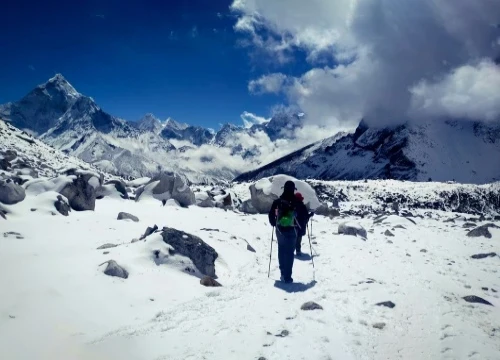Unveiling the Untamed: Exploring the Remarkable Wildlife of the Everest Region
The diverse ecosystem of the Everest Region
The Everest region is not only famous for its towering peaks and challenging treks but also for its rich and diverse ecosystem. This region is home to a wide range of habitats, including alpine meadows, subalpine forests, and high-altitude wetlands. These varied landscapes create the perfect conditions for a diverse array of wildlife species to thrive.
In the lower valleys, you'll find lush forests of oak, rhododendron, and birch, which provide shelter and food for a variety of wildlife. As you ascend higher, the landscape transitions to alpine meadows and rocky slopes, where hardy plants like juniper and dwarf rhododendron cling to the barren terrain. These unique ecosystems support a remarkable diversity of wildlife, making the Everest region a haven for nature lovers.
Iconic wildlife species in the Everest Region
The Everest region is home to several iconic wildlife species that have captured the imagination of adventurers and explorers for centuries. One such species is the elusive snow leopard, a solitary and highly adaptable predator that roams the rugged mountain slopes. With its thick fur and powerful build, the snow leopard is perfectly adapted to survive in the harsh conditions of the Himalayas.
Another remarkable creature that calls this region home is the Himalayan tahr. These agile and sure-footed herbivores are known for their ability to navigate the treacherous cliffs with ease. With their thick coats and curved horns, they are well-equipped to survive in the extreme cold and rocky terrain of the Everest region.
Endangered wildlife species in the Everest Region
Unfortunately, the Everest region is not immune to the threats faced by wildlife around the world. Several species in this region are classified as endangered or vulnerable, making their conservation of utmost importance. One such species is the red panda, a charming and elusive creature that inhabits the dense bamboo forests of the region. Deforestation and poaching have led to a decline in their population, making their protection a pressing concern.
Another endangered species in the Everest region is the Himalayan black bear. These magnificent creatures are known for their distinctive white chest patches and are an important part of the ecosystem. However, habitat loss and poaching have led to a decline in their numbers, highlighting the need for conservation efforts to protect these majestic animals.
Wildlife conservation efforts in the Everest Region
Recognizing the importance of preserving the unique wildlife of the Everest region, various conservation organizations and local communities have come together to protect these precious species. One such initiative is the Sagarmatha National Park, a UNESCO World Heritage site that covers a significant portion of the Everest region. The park serves as a sanctuary for numerous wildlife species and plays a vital role in their conservation.
In addition to protected areas, community-led conservation projects have also been established to promote sustainable practices and raise awareness about the importance of wildlife preservation. These initiatives not only benefit the wildlife but also provide economic opportunities for local communities through responsible tourism.
Best wildlife viewing spots in the Everest Region
If you're hoping to catch a glimpse of the remarkable wildlife in the Everest region, there are several spots that offer excellent opportunities for wildlife sightings. One such place is the Gokyo Valley, a picturesque valley situated at the base of Gokyo Ri. Here, you can spot a variety of bird species, including the colorful lophophorus, also known as the Danphe, which is the national bird of Nepal.
Another popular spot for wildlife enthusiasts is the Tengboche Monastery. Located at an elevation of 3,867 meters, this serene monastery offers stunning views of the surrounding peaks and is a great place to spot musk deer and Himalayan pheasants. Keep your eyes peeled for the elusive snow leopard, as this area is known for its occasional sightings of this magnificent predator.
Tips for wildlife photography in the Everest Region
If you're passionate about wildlife photography, the Everest region offers a myriad of opportunities to capture stunning images of these remarkable creatures. Here are a few tips to help you make the most of your photography expedition:
- Be patient: Wildlife photography requires patience and persistence. Spend time observing the behavior of the animals and anticipating their movements to capture the perfect shot.
- Use the right equipment: Invest in a good telephoto lens to capture distant subjects and a sturdy tripod to keep your camera steady in challenging conditions.
- Respect the wildlife: Remember that you are a guest in their home. Maintain a respectful distance and avoid disturbing or stressing the animals for the sake of a photograph.
Responsible tourism and wildlife preservation in the Everest Region
As visitors flock to the Everest region in search of adventure and natural beauty, it is crucial to prioritize responsible tourism practices to ensure the long-term preservation of the region's wildlife. This includes following established trekking routes, respecting the local culture and customs, and minimizing your impact on the environment.
Additionally, supporting local conservation initiatives and responsible tour operators can contribute directly to the preservation of the region's wildlife. By choosing operators that prioritize sustainable practices and community engagement, you can help ensure a brighter future for the remarkable wildlife of the Everest region.
Trekking routes that offer wildlife sightings in the Everest Region
While the Everest Base Camp trek is undoubtedly a popular choice for adventurers, there are several other trekking routes in the region that offer unique opportunities to spot wildlife. One such route is the Gokyo Lakes trek andEverest three passes trek which takes you through the stunning Gokyo Valley and is a circuit of Everest region trekking trail which offers excellent chances to spot a variety of bird species and mammals.
Another alternative route is the Mani Rimdu trek, which combines breathtaking mountain vistas with cultural experiences. This trek takes you through the picturesque villages of the region, where you may encounter wildlife such as musk deer and Himalayan tahr along the way.
Conclusion: The importance of preserving the wildlife in the Everest Region
The Everest region is a treasure trove of remarkable wildlife, from the elusive snow leopard to the vibrant lophophores. As we explore this untamed wilderness, it is crucial that we prioritize the preservation of these incredible creatures. By supporting conservation efforts, practicing responsible tourism, and raising awareness about wildlife protection, we can ensure that future generations will have the opportunity to witness the untamed beauty of the Everest region's remarkable wildlife. So, lace up your boots, grab your camera, and let the wonders of the Everest region inspire you to become a champion for wildlife preservation.







